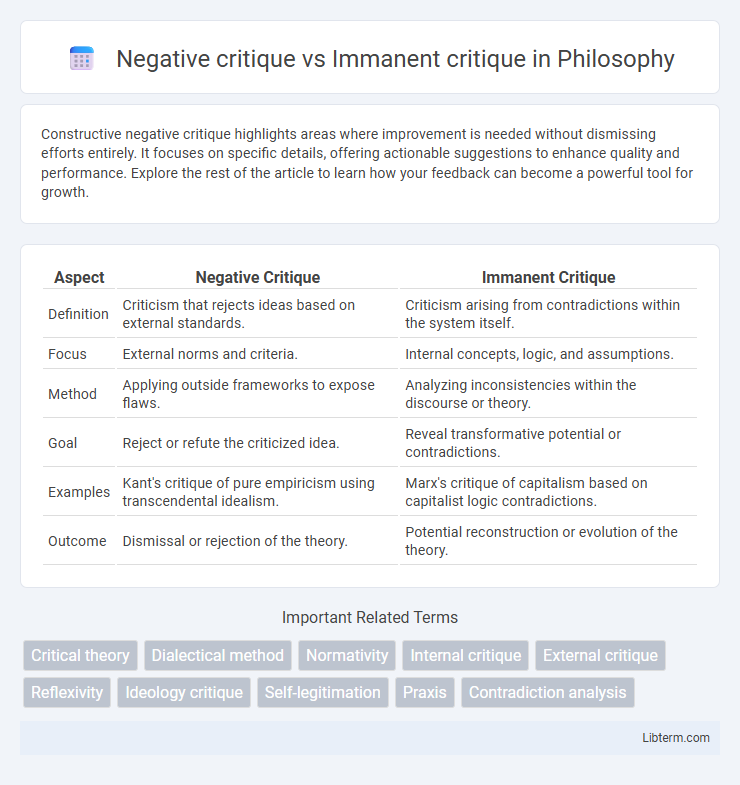Constructive negative critique highlights areas where improvement is needed without dismissing efforts entirely. It focuses on specific details, offering actionable suggestions to enhance quality and performance. Explore the rest of the article to learn how your feedback can become a powerful tool for growth.
Table of Comparison
| Aspect | Negative Critique | Immanent Critique |
|---|---|---|
| Definition | Criticism that rejects ideas based on external standards. | Criticism arising from contradictions within the system itself. |
| Focus | External norms and criteria. | Internal concepts, logic, and assumptions. |
| Method | Applying outside frameworks to expose flaws. | Analyzing inconsistencies within the discourse or theory. |
| Goal | Reject or refute the criticized idea. | Reveal transformative potential or contradictions. |
| Examples | Kant's critique of pure empiricism using transcendental idealism. | Marx's critique of capitalism based on capitalist logic contradictions. |
| Outcome | Dismissal or rejection of the theory. | Potential reconstruction or evolution of the theory. |
Introduction to Critical Analysis
Negative critique focuses on identifying flaws and contradictions within a text or argument, often highlighting what is wrong without offering alternatives. Immanent critique, by contrast, analyzes a work from within its own framework and principles, uncovering inconsistencies while remaining faithful to its internal logic. In critical analysis, immanent critique provides a deeper understanding by revealing tensions and potential developments inherent in the text, fostering constructive dialogue rather than outright rejection.
Defining Negative Critique
Negative critique identifies contradictions and flaws within existing social structures by exposing their limitations and injustices, aiming to undermine established ideologies without offering immediate alternatives. It focuses on the external critique of systems, emphasizing what is wrong or oppressive in current arrangements. This approach contrasts with immanent critique, which reveals internal inconsistencies from within a system's own principles and values.
Understanding Immanent Critique
Immanent critique involves analyzing ideas or systems from within their own framework, revealing inherent contradictions and potential for transformation without external judgment. Understanding immanent critique reveals how it identifies limitations and possibilities in a concept by closely engaging with its internal logic and assumptions. This method contrasts with negative critique, which often dismisses ideas outright rather than exploring their intrinsic dynamics and developmental potential.
Historical Origins and Philosophical Background
Negative critique traces its origins to the Socratic method of elenchus, emphasizing the deconstruction of false beliefs through cross-examination to reveal contradictions and errors. Immanent critique, rooted in Hegelian dialectics and later expanded by Marxist philosophy, focuses on evaluating ideas or social structures from within their own conceptual framework to expose internal inconsistencies and unrealized potentials. The philosophical background of negative critique is grounded in classical skepticism, while immanent critique evolves from dialectical reasoning that seeks transformation by revealing hidden contradictions inherent to a system.
Key Differences Between Negative and Immanent Critique
Negative critique fundamentally challenges ideas by identifying contradictions from an external standpoint, seeking to expose flaws without necessarily offering solutions. Immanent critique operates from within the system or theory, highlighting inconsistencies by engaging directly with its internal logic to prompt self-correction and transformation. The key difference lies in external opposition versus internal evaluation, where negative critique rejects from outside while immanent critique fosters change from inside.
Methodologies of Critique: Comparing Approaches
Negative critique primarily employs a deconstructive methodology, aiming to identify and expose contradictions or flaws within a system without proposing alternatives. Immanent critique, by contrast, utilizes an internal analytical approach that assesses a system based on its own values and principles, revealing inconsistencies between ideals and practices. Both methodologies emphasize rigorous examination, but immanent critique offers a constructive framework to guide reform rather than solely highlighting deficiencies.
Strengths and Weaknesses of Negative Critique
Negative critique excels at identifying contradictions and flaws within a specific theory or argument, providing a clear, focused deconstruction that can expose fundamental weaknesses. However, its primary weakness lies in its often destructive nature, as it tends to reject ideas without offering constructive alternatives or pathways for improvement. This limited scope can hinder progress by emphasizing negation over development, contrasting with immanent critique which seeks to evaluate internal coherence and growth potential from within the system.
Advantages and Limitations of Immanent Critique
Immanent critique offers the advantage of analyzing a text or theory from within its own conceptual framework, revealing internal contradictions and overlooked assumptions more effectively than negative critique, which tends to impose external perspectives. This method promotes a deeper understanding and constructive reformulation by staying true to the original context, enhancing the relevance and persuasiveness of the critical analysis. However, its limitation lies in potential bias or blind spots due to the reliance on the internal logic of the subject, possibly overlooking broader social or historical factors that external critique might highlight.
Case Studies: Applying Both Critiques in Practice
Case studies applying negative critique reveal flaws and contradictions by contrasting ideals with reality, exposing systemic inconsistencies and highlighting areas for reform. Immanent critique in practice delves within the system's own values and logic, uncovering latent tensions that hinder progress and suggesting transformations aligned with foundational principles. Comparing both approaches in case studies enables a comprehensive analysis, balancing external judgment with internal coherence to foster deeper understanding and effective change.
Conclusion: Choosing the Right Critical Framework
Negative critique highlights contradictions and flaws in existing theories or systems, promoting rejection or reform based on external standards. Immanent critique, by contrast, evaluates ideas or social orders from within their own principles, revealing inconsistencies without imposing outside norms. Selecting the appropriate critical framework depends on the goal--whether to challenge from an external vantage point or to deepen understanding through internal coherence.
Negative critique Infographic

 libterm.com
libterm.com